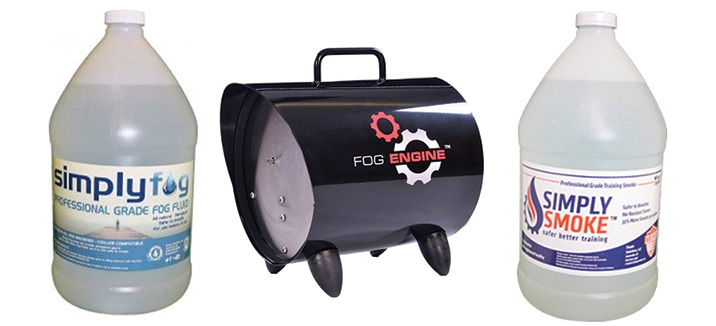
TECHNOLOGY TODAY ❘ By STACY TODD
For years, firefighter training classes have used training smoke fluid to simulate an active fire scene, yet little has been written about the healthfulness and risks associated with this practice. More information is now available, and we are learning that some training activities—meant to teach how to minimize risk and injury—might be harming our firefighters. One firm, Simply Solutions, LLC, has recognized this and addressed the issue.

(1) Photo courtesy of Simply Solutions, LLC.
Simulated smoke fluids are vaporized in a smoke generating appliance (by adding heat) and are then “shot out” of that appliance. There are three basic types of training smoke fluids: mineral oil-based, glycol-based, and glycerin formulas. The use of mineral oil-based fluids has been greatly diminished because of the known respiratory issues and residue. Glycol-based smoke fluids are customary and the majority of what is used today, and they produce significant smoke when used in a well-tuned smoke generator, but there are problems.
The first problem with glycol-based smoke fluids is chemistry. Glycols have a carbon atom that, when released during heating above the boiling point, can break apart and combine with hydrogen and oxygen in the atmosphere to form formaldehyde. Formaldehyde is a known carcinogen, and many of our firefighters are being exposed to it on a regular basis.
Although relatively benign as a compound at room temperature, when heated above 370°F, glycols decompose. Most smoke generators operate at a temperature of 450°F or greater, so the decomposition of the glycol and the formation of formaldehyde are common. Firefighters can then ingest the created formaldehyde through their lungs and skin. In fact, all the major producers of glycols, including Dow Chemical, Shell Chemical, and others, explicitly recommend that glycols NOT be used in the production of theatrical/training smoke. As reported through the National Institutes of Health, theatrical fog/smoke featuring glycols were studied with the result that, “Acute cough and dry throat were associated with acute exposure to glycol-based fogs; increased acute upper airway symptoms were associated with increased fog aerosol overall. Lung function was significantly lower among those working closest to the fog source.”1
To simulate heat, a live fire is often incorporated along with training smoke to create an even more realistic training situation. Unfortunately, this scenario can add even more of a health risk. The glycols can combine with carbon from the live burn to produce even more formaldehyde, increasing firefighter cancer risk. Additionally, glycols are known cell membrane inhibitors, which are used to deliver compounds into the bloodstream. (This is why glycols are often used to deliver nicotine into the bloodstream through vaping devices.) If formaldehyde or other chemicals are present, glycols can readily deliver those foreign elements into the body, which can happen through the lungs and skin.
A final concern is chemical deposits from glycol-based smoke fluids. These fluids tend to coat floors, equipment, and clothing and can create slippery floors and other surfaces, increasing firefighter injury risk.
Also consider different training smoke formulas. The lead and, perhaps, the best formulation is nonglycol and features a different element—glycerin—which can also produce thick, dense simulated smoke. Glycerin is a natural ingredient often sourced from the leaves of plants. Its chemical composition has no carbon atom, so it cannot break down to form formaldehyde. In fact, the boiling point of glycerin-based smoke fluid is over 550°F—much higher than glycols. That boiling point is also well above the typical operating temperature of smoke generating machines, so decomposition is unlikely. Given the chemical makeup of glycerin smoke fluid, even if it does decompose, the results are benign: carbon dioxide and water.
Glycerin has been tested for safety at least 56 times by the National Institutes for Occupational Safety and Health (NIOSH). These tests include tests for toxicity, eye irritation, skin irritation, and several other effects. Unlike glycols, the use of glycerin in the production of theatrical/training fog has never been dissuaded by NIOSH or glycerin manufacturers. Additionally, glycerin-based smoke fluids tend to vaporize more completely and leave little or no residue. That applies to floors, equipment, clothing, and skin.
Finally, because of its composition, a glycerin-based fog fluid generates approximately 33 percent more fog per unit of fluid vs. glycol. This offers trainers a significant economic advantage: either more fog per gallon or the need to buy less fluid. Simply Solutions, LLC, has been producing glycerin-based smoke fluids under the brands Simply Fog® and Simply Smoke™ for almost five years. Additionally, the company has introduced its “Fog Engine,” an advanced smoke generator that accurately controls the vaporization temperature, allowing for a safer operating range, and produces continuous smoke. It is Bluetooth-controlled, and the smartphone app can manage multiple smoke machines simultaneously.
Attention to the health of our firefighters is an important and ongoing process. As research continues and better information is obtained, all parties involved must disseminate this information. Let’s keep safe those who risk their lives to keep us safe.
Reference
1. www.ncbi.nlm.nih.gov/pubmed/15828073.
STACY TODD is the sales director for Simply Solutions, LLC.

